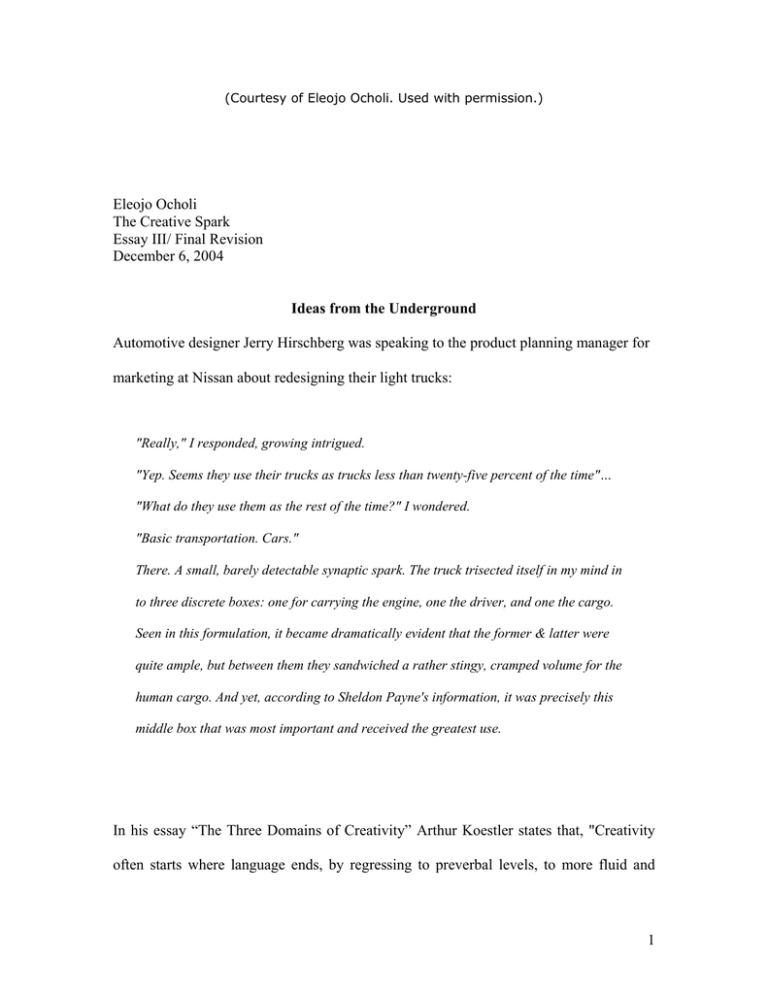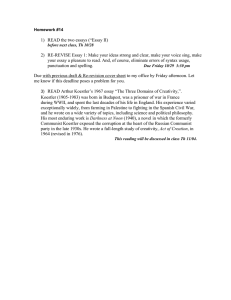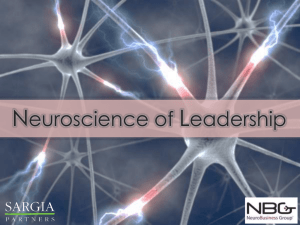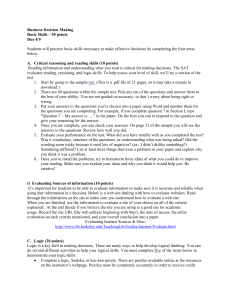Eleojo Ocholi The Creative Spark Essay III/ Final Revision December 6, 2004
advertisement

(Courtesy of Eleojo Ocholi. Used with permission.) Eleojo Ocholi The Creative Spark Essay III/ Final Revision December 6, 2004 Ideas from the Underground Automotive designer Jerry Hirschberg was speaking to the product planning manager for marketing at Nissan about redesigning their light trucks: "Really," I responded, growing intrigued. "Yep. Seems they use their trucks as trucks less than twenty-five percent of the time"… "What do they use them as the rest of the time?" I wondered. "Basic transportation. Cars." There. A small, barely detectable synaptic spark. The truck trisected itself in my mind in to three discrete boxes: one for carrying the engine, one the driver, and one the cargo. Seen in this formulation, it became dramatically evident that the former & latter were quite ample, but between them they sandwiched a rather stingy, cramped volume for the human cargo. And yet, according to Sheldon Payne's information, it was precisely this middle box that was most important and received the greatest use. In his essay “The Three Domains of Creativity” Arthur Koestler states that, "Creativity often starts where language ends, by regressing to preverbal levels, to more fluid and 1 uncommitted forms of mental activity." Although at that point in the essay, he is speaking of scientific creativity, later on he conveys that it can be applied to almost any kind of creativity. Take Hirshberg in the above passage as an example. He was trying to access the raw information gathered by the marketing department at Nissan about what improvements consumers wanted in the light trucks. When he got to a point where his idea began to form in his mind, he stopped talking and started visualizing how he could redesign the new model of the truck. Another example of non-verbal thinking is shown in Ron Howard’s film A Beautiful Mind, where John Nash is in a bar with his friends and he reasons out his new idea that won a Nobel Prize. His reasoning on the screen is shown as images of his friends and the girls they are trying to “get”, as he thinks of how they could all win. The scene mirrors how he came up with his revolutionary theory. Koestler also emphasizes this idea of the visual playing a greater part in creativity than verbal thinking with the results of an inquiry, in 1945, into the working methods of eminent mathematicians in America. He wrote, “The results showed that all of them, with only two exceptions, thought neither in verbal terms nor in algebraic symbols but relied on visual imagery of a vague, hazy kind.” The thing about language is that there are only so many words you can use to express a viewpoint or an idea. For me, when I have an idea, for example when writing an essay, I spend half the time thinking of a word that will fit the new idea instead of concentrating on developing it. Effectively language at that point is providing a stumbling block to my creativity. Sometimes, I even lose the idea. 2 Yet it is not so much verbal reasoning as disciplined, logical thinking that can potentially block or impede creativity. Koestler lays particular emphasis on the “hunches of unconscious origin” as an important factor in the act of (scientific) discovery. Rollo May echoes this in his book The Courage to Create. He remarks that, “Now this intensity of awareness is not necessarily connected with conscious purpose or willing. It may occur in reverie or in dreams, or from so-called unconscious levels.” I understood the “intensity of awareness” to be the process of creation. He goes on to talk about how creativity continues on different levels not controlled by the conscious willing. This idea has been generally accepted and even glorified in movies, novels, comics and other media that report creative acts. At the point he starts reasoning, Hirshberg describes his creative moment with, “There. A small, barely detectable synaptic spark.” Many writers have tried to explain what exactly goes on at the point where the breakthrough is made. We can only describe the feelings we have when we experience it. Koestler remarks that we need to think of levels of thinking between the primary process, which is devoid of logic and governed by the pleasure principles, and the secondary process of reality; where each level has its own rules. “The paranoid delusion, the dream, the daydream, free association, the mentalities of children of various ages and of primitives at various stages...” says Koestler “while clearly different in many respects, all these forms of mentation have certain features in common… They are less rigid, more tolerant and more ready to combine seemingly incompatible ideas…” In other words they are conducive for creativity. Generally our minds follow certain patterns of logic when trying to solve a problem and so any ideas that don’t fit in the patterns are not considered. Yet in the areas of the unconscious mentioned above, the mind cannot be controlled. 3 Koestler calls thinking on the levels of the unconscious mentioned above “games of the underground” that would play havoc with disciplined thinking methods but, “when disciplined thinking is at the end of its tether, a temporary indulgence in these underground games may suddenly produce a solution – some farfetched reckless combination which would be beyond the reach of, or seem to be unacceptable to, the sober, rational mind.” May writes similarly that “the insight broke into my conscious mind against what I had been trying to think rationally…The unconscious so to speak, broke through in opposition to the conscious belief to which I was clinging.” Referring to the unconscious levels of thinking as “underground” portrays them as dangerous levels that one should be wary of. Yet these “unconscious”, “extraconscious” or “underground” levels of thinking in a person’s mind are key to imagination. I have certainly gone through these processes in my academic endeavors. After dwelling on a difficult question in a problem set for an hour or more, all my logical reasoning comes to nothing and my thinking is at “the end of its tether”. Thus I stop thinking about it, yet it seems the problem is still being mulled over in my unconscious because out of the blue, when I’m walking down the infinite corridor or the student center steps, the answer hits me. As Koestler says, “The place for the rendezvous of ideas is underground.” Disciplined thinking is more efficient and even necessary to begin the act of “creation” but then at the crucial point of reasoning, it seems that one always has to give in to some level of “semi-abandon”, or extraconsciousness in order to solve the problem or let the new idea come forth. But even then the importance of verbal reasoning should not be forgotten, because as Koestler says, “Words crystallize thoughts…” Sometimes, at 4 least in my experience, I reach a point where I have too many ideas floating around; where the “games of the underground” have begun to play havoc. I must either write down my ideas or voice them out in order not to lose them in the sea of fluid thoughts in my mind. Lots of times I am frustrated when I almost get the answer only to be foiled by my own mind producing both useful and useless ideas or solutions. At such points when havoc is being played, disciplined or verbal reasoning is required to sort out, extract and purify the crystal of creation from the ore of ideas and thoughts floating in the mind. Thus to create, one needs to reason logically, step back briefly from logic and then use logical reasoning to express what has been discovered. 5





